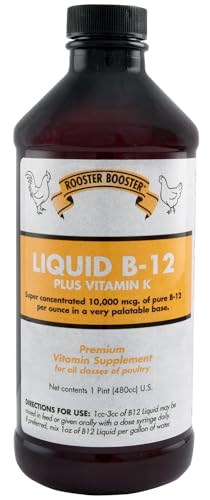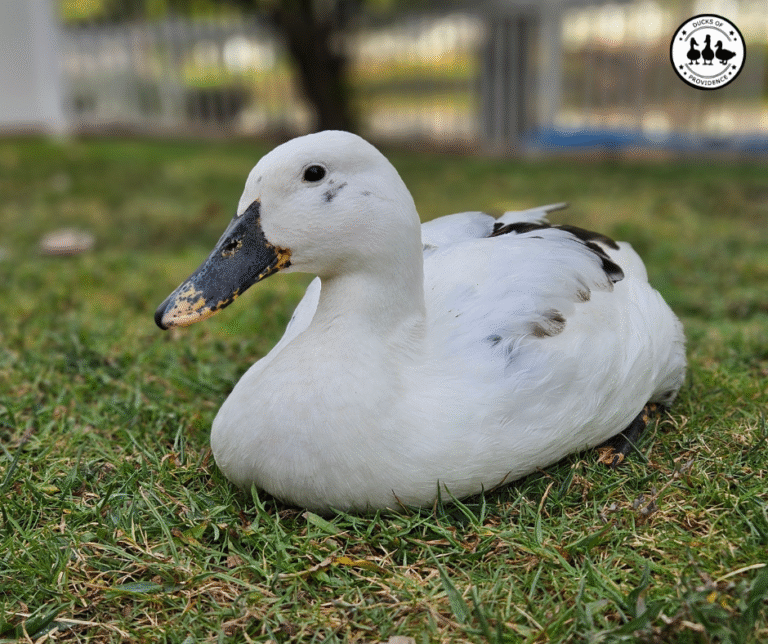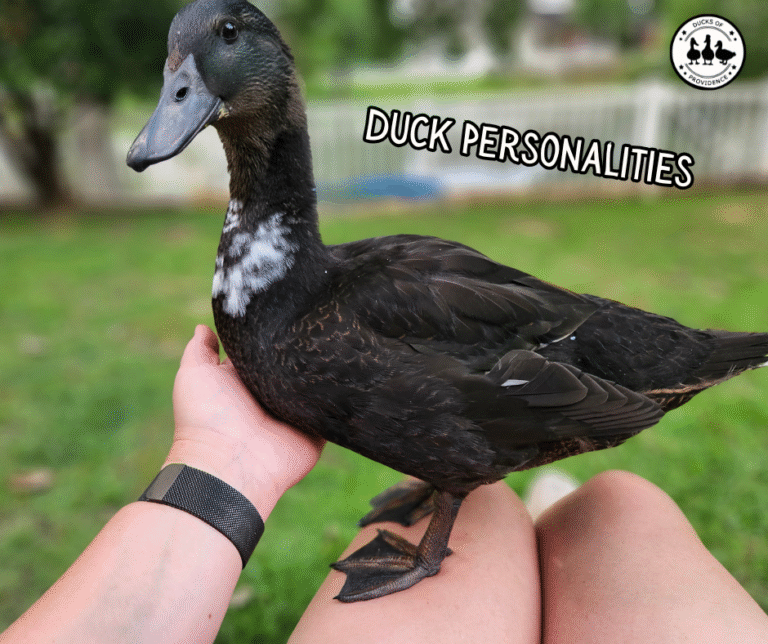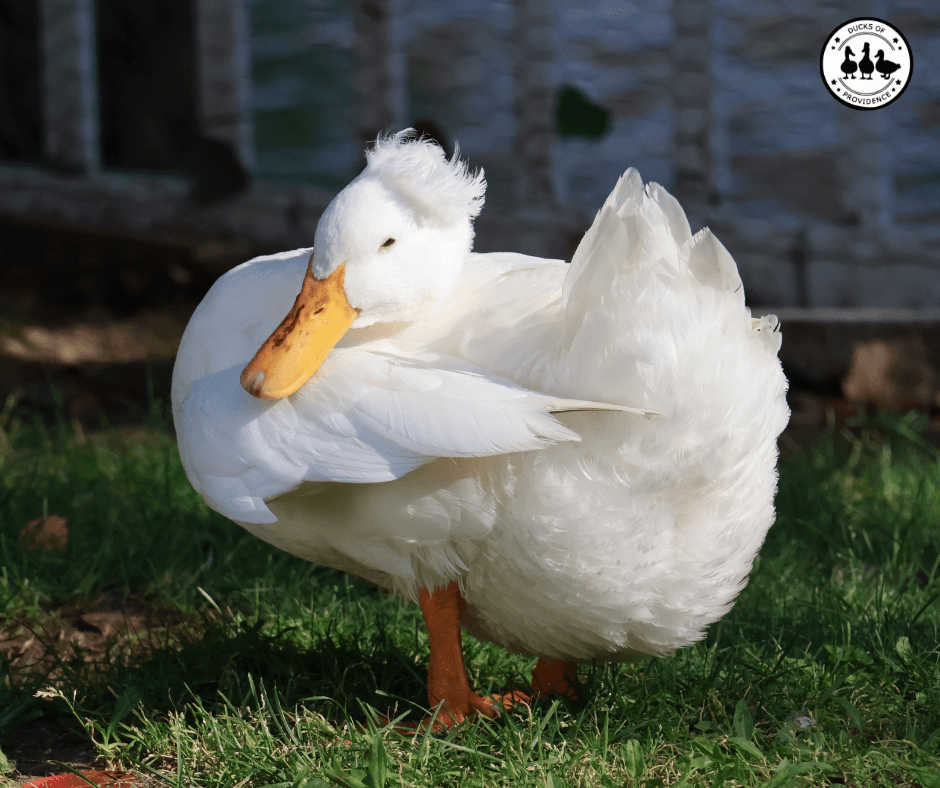
Wry Neck in Ducks: Causes, Care, and Recovery Tips
Wry neck, also known as torticollis, is a condition in ducks in which the neck twists and the bird’s head turns to one side. It can be distressing for duck owners, but with proper care and intervention, many ducks can recover. There are several potential causes of wry neck in ducks, ranging from nutritional deficiencies to neurological issues or infections. Understanding the cause is key to determining the right treatment.
This article is part of our Duck Health Conditions Series.
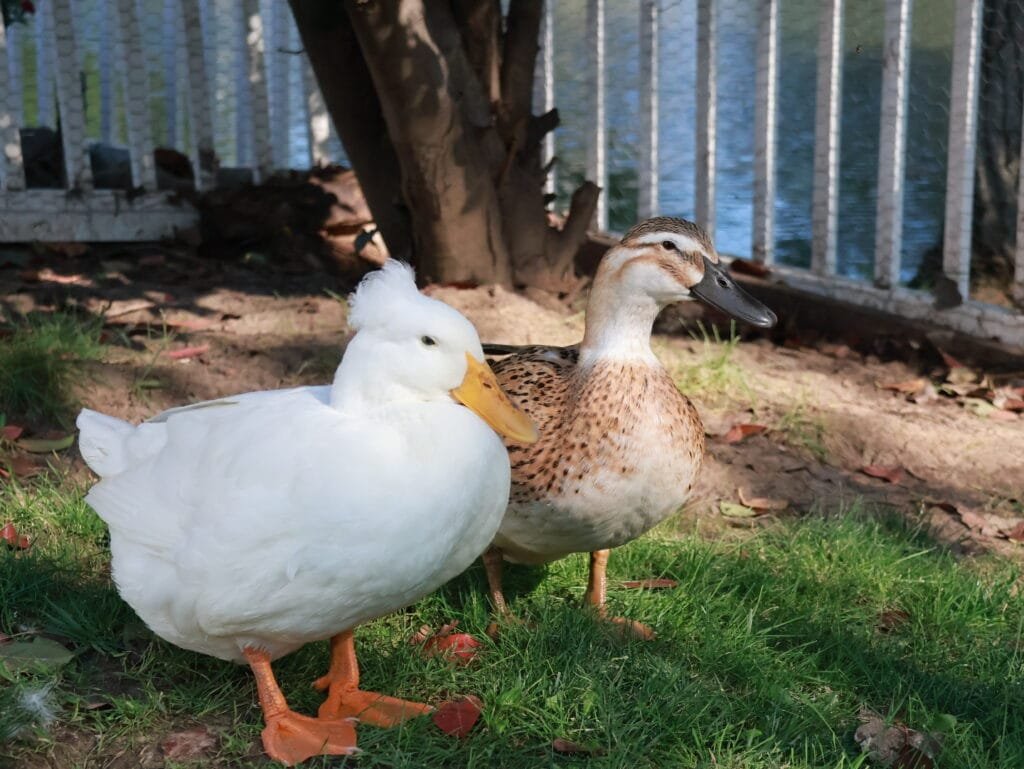
Disclaimer: I may earn a commission if you buy products or services through my affiliate links. This will not affect the price you pay. I only recommend products or services that I believe will be beneficial to my readers.
Causes of Wry Neck in Ducks
Wry neck, also known as torticollis, can result from a variety of underlying conditions. Understanding the root cause is critical for determining the appropriate treatment and care for affected ducks. Below are the main causes of wry neck, expanded for clarity and depth:
1. Nutritional Deficiencies
A lack of essential nutrients, particularly vitamins and minerals, is one of the most common causes of wry neck in ducks.
Ducks need adequate vitamin E for proper neurological function and muscle control. Deficiency may result from:
- Poor-quality feed.
- Improperly stored feed leading to oxidation.
- A lack of green vegetables in the diet.
Selenium works in conjunction with vitamin E to protect cells from damage. Deficiency may occur due to:
- Inadequate levels in commercial feeds.
- Poor-quality soil in foraging areas.
Thiamine (Vitamin B1) deficiency, essential for nerve function, can also cause wry neck. Risks include:
- Diets predominantly low in thiamine.
- Excessive feeding of cracked corn or low-quality grains.
Warning: Wry neck can sometimes be caused by medicated feed, which interferes with thiamine absorption and should NEVER be given to waterfowl. This issue is more commonly seen in chickens than in ducks and geese, as we have learned from Majestic Waterfowl. Always ensure that the feed provided to your ducks is appropriate for their dietary needs.
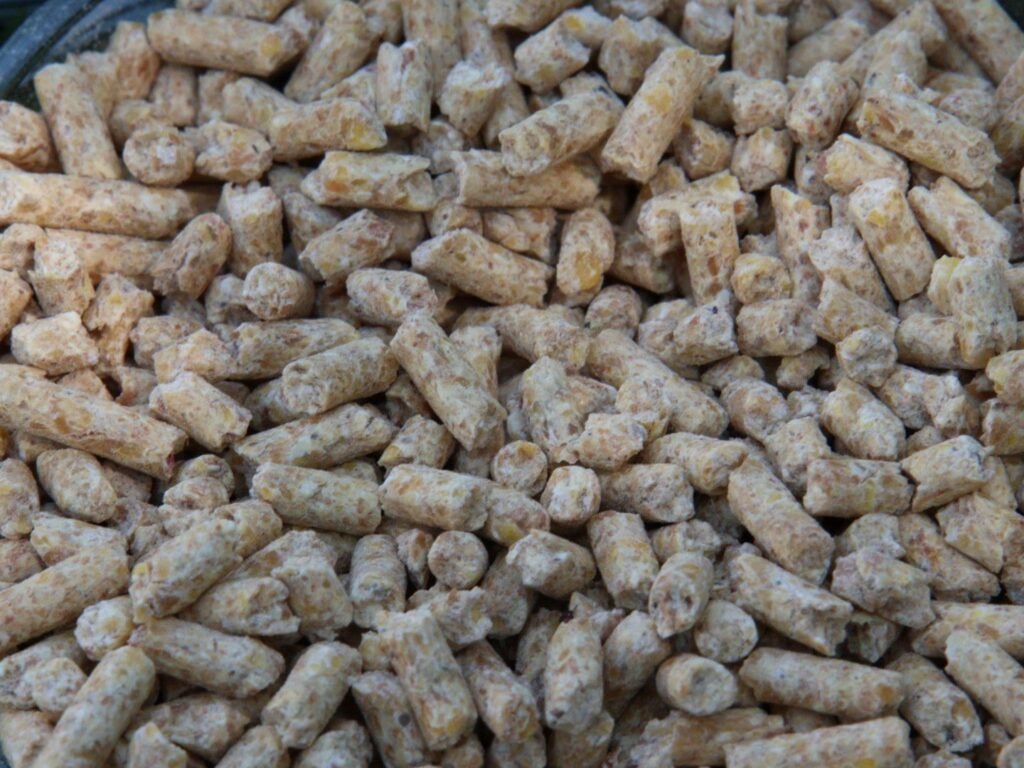
2. Genetic Predisposition
Certain duck breeds, particularly ornamental or exhibition breeds, may be more susceptible to wry neck due to genetic factors. These breeds often have unique skeletal or neurological traits.
3. Head or Neck Injury
Trauma to the head or neck can damage nerves, muscles, or the brain. This could occur due to rough handling, fights with other ducks, predator attacks, or accidents in the environment. Even a minor injury can lead to twisting of the neck if it disrupts the bird’s balance or motor function.
4. Neurological Disorders
Damage to the nervous system can impair the duck’s ability to control its neck movements. Infections like Newcastle disease, avian encephalomyelitis, or botulism can cause neurological symptoms, including wry neck. Brain swelling (encephalitis) due to infection, injury, or an autoimmune response can press on nerves controlling the neck.
5. Toxicity or Poisoning
Exposure to certain toxins can cause nerve damage, leading to wry neck. Ducks exposed to stagnant water or decaying organic material may ingest the toxin produced by Clostridium botulinum, resulting in paralysis and neck twisting. Heavy metal poisoning, such as ingestion of lead or zinc from old paint, fishing weights, or galvanized materials, can result in neurological damage.
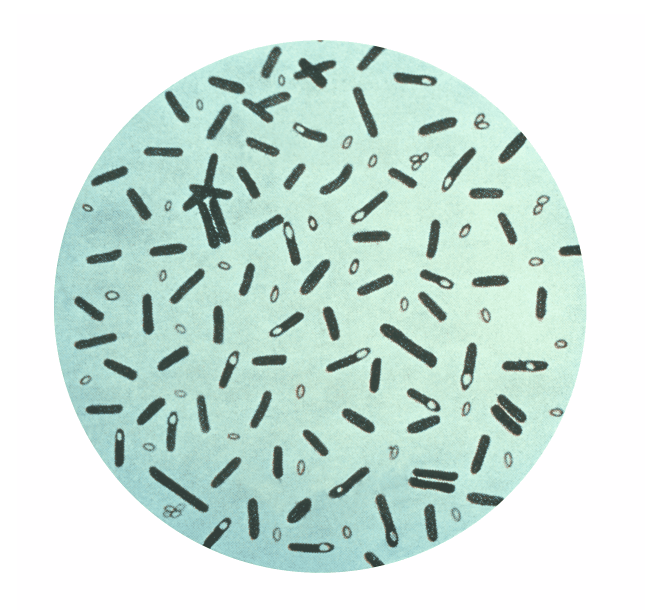
6. Viral or Bacterial Infections
Infections affecting the central nervous system may present as wry neck in ducks. Viral infections like avian influenza or avian encephalomyelitis can cause neurological symptoms. Bacterial infections, especially if they spread to the brain or inner ear, can interfere with balance and motor function.
7. Inner Ear Infections
Ducks rely on their inner ears for balance. An infection or injury in this area can cause disorientation and neck twisting. Symptoms of ear infections often include head shaking, discharge from the ear, and redness around the ear canal.
8. Stress or Environmental Factors
Chronic stress or exposure to extreme environmental conditions can exacerbate underlying issues, such as vitamin deficiencies or susceptibility to infections.
9. Exposure to Toxins in Feed or Water
Contaminated feed or water can introduce mold toxins (mycotoxins) or bacteria harmful to the nervous system. Poorly stored feed is a common source of such toxins.

10. Congenital Conditions
Some ducklings may hatch with wry neck due to developmental abnormalities. These issues often arise from improper incubation conditions, such as fluctuating temperatures or poor egg turning during incubation.
Why Determining the Cause Matters
Identifying the specific cause of wry neck is essential because it influences the treatment plan. Nutritional deficiencies often respond well to supplements like vitamin E and selenium. Infections may require antibiotics or antiviral medications. Injuries may need supportive care and time to heal. Addressing the root cause promptly can significantly improve the prognosis and quality of life for the affected duck.
Symptoms of Wry Neck in Ducks
Wry neck in ducks can present with a range of symptoms that vary in severity, depending on the underlying cause and how long the condition has persisted. Recognizing the signs early is crucial for effective treatment. Below are the most common symptoms to watch for:
1. Twisting or Tilting of the Neck
The hallmark symptom of wry neck is the visible twisting or tilting of the neck. This can range from mild to severe:
- Mild cases: The duck’s neck may appear slightly tilted to one side, but the bird can still function relatively normally.
- Severe cases: The duck’s head may be completely twisted backward, often making it difficult for the bird to lift its head, walk, or eat.
2. Difficulty Walking or Maintaining Balance
The unnatural position of the neck often throws off the duck’s sense of balance:
- Ducks may stumble, fall, or have difficulty walking in a straight line.
- They may appear uncoordinated or reluctant to move, especially if the twisting causes dizziness or disorientation.
3. Lethargy and Weakness
Ducks with wry neck often exhibit signs of overall fatigue, which may include:
- Spending more time resting or lying down.
- A lack of interest in socializing with other ducks.
- Slower movements and reduced activity levels.
4. Inability to Eat or Drink Properly
Severe neck twisting can make it challenging for the duck to position its beak correctly to access food or water:
- You may notice the duck pecking unsuccessfully at food or water bowls.
- Over time, this can lead to weight loss and dehydration if not addressed.

5. Eye Abnormalities
The twisting of the neck can sometimes affect the duck’s eyes due to nerve involvement:
- One or both eyes may twitch, appear unfocused, or move abnormally.
- The duck may struggle to focus on objects, adding to its difficulty eating or drinking.
6. Head Tremors or Shaking
In some cases, ducks with wry neck may exhibit tremors or shaking movements in their head or neck:
- This is often due to muscle spasms or neurological issues.
- The tremors can worsen with stress or when the duck tries to move.
7. Loss of Appetite
The combination of difficulty eating, stress, and disorientation often results in reduced appetite. Ducks may:
- Show little interest in food they previously enjoyed.
- Lose weight over time if the issue isn’t resolved.
8. Reluctance to Swim
Swimming requires coordination and balance, so ducks with wry neck may avoid the water:
- They may stay on the shore while the rest of the flock swims.
- If they do enter the water, they may struggle to keep their head upright or swim in circles.
No Swimming: Waterfowl with wry neck should NEVER be allowed in water or have unsupervised access to water. They require constant, hands-on supervision to prevent drowning accidents.
9. Social Withdrawal
Ducks with wry neck often isolate themselves from the rest of the flock:
- This behavior may stem from difficulty keeping up with others or feeling vulnerable.
- Social withdrawal can also indicate general discomfort or stress.
10. Stress or Anxiety
The condition can cause significant stress for the duck, as it struggles to perform everyday tasks like eating, drinking, or grooming:
- Signs of stress may include increased vocalizations, panting, or rapid heart rate.
- The duck may also become more skittish or agitated when handled.
11. Feather Disarray or Poor Grooming
Ducks with wry neck often struggle to preen themselves due to their limited range of motion:
- Feathers may appear disheveled, dirty, or clumped together.
- Over time, this can lead to skin issues or feather loss if the bird cannot maintain hygiene.
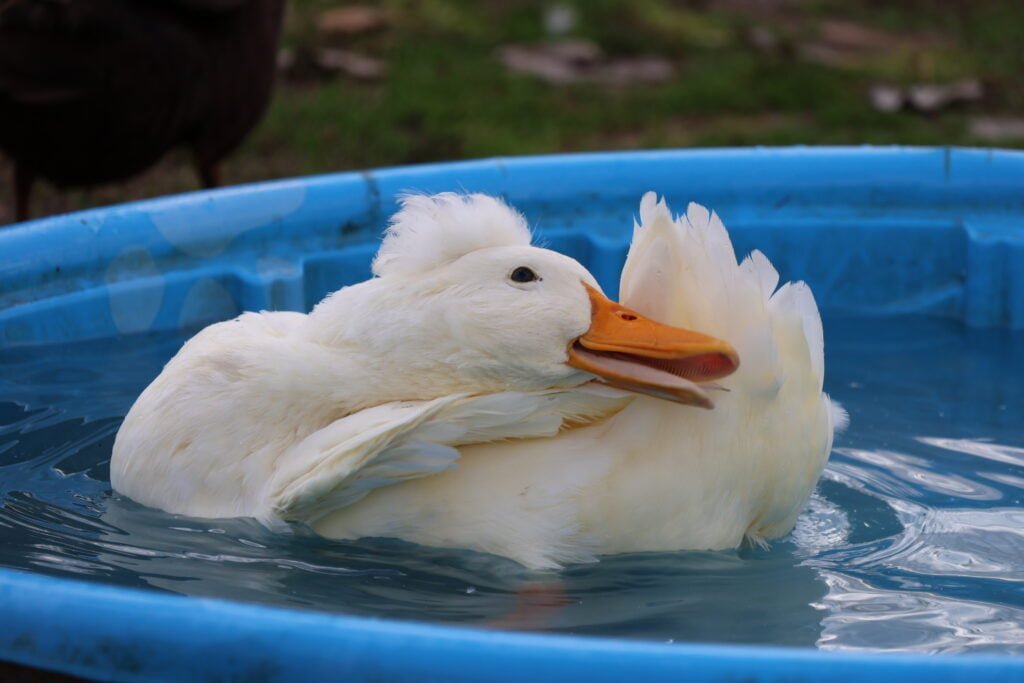
Complications from Untreated Wry Neck
If wry neck is not treated promptly, additional complications can arise:
- Malnutrition: The inability to eat properly can lead to rapid weight loss and nutritional deficiencies.
- Dehydration: Difficulty accessing water may result in dehydration, which can exacerbate the condition.
- Weak Immune System: A lack of proper nutrition and hydration can weaken the duck’s immune system, making it more susceptible to infections.
- Permanent Neck Deformity: Prolonged wry neck without treatment can lead to irreversible muscle or nerve damage.
Pay close attention to these symptoms and monitor any changes in your duck’s behavior or physical condition. Early intervention can make a significant difference in the outcome for ducks with wry neck.
Treatment for Wry Neck in Ducks
Treating wry neck in ducks involves addressing the root cause and providing supportive care to help the bird recover. Below is a detailed breakdown of treatment strategies under specific subheadings:
1. Isolate the Affected Duck
Begin by isolating the duck in a quiet, safe area to reduce stress and prevent bullying by other ducks. Isolation makes it easier to monitor symptoms, administer care, and ensure flockmates do not further injure the duck.
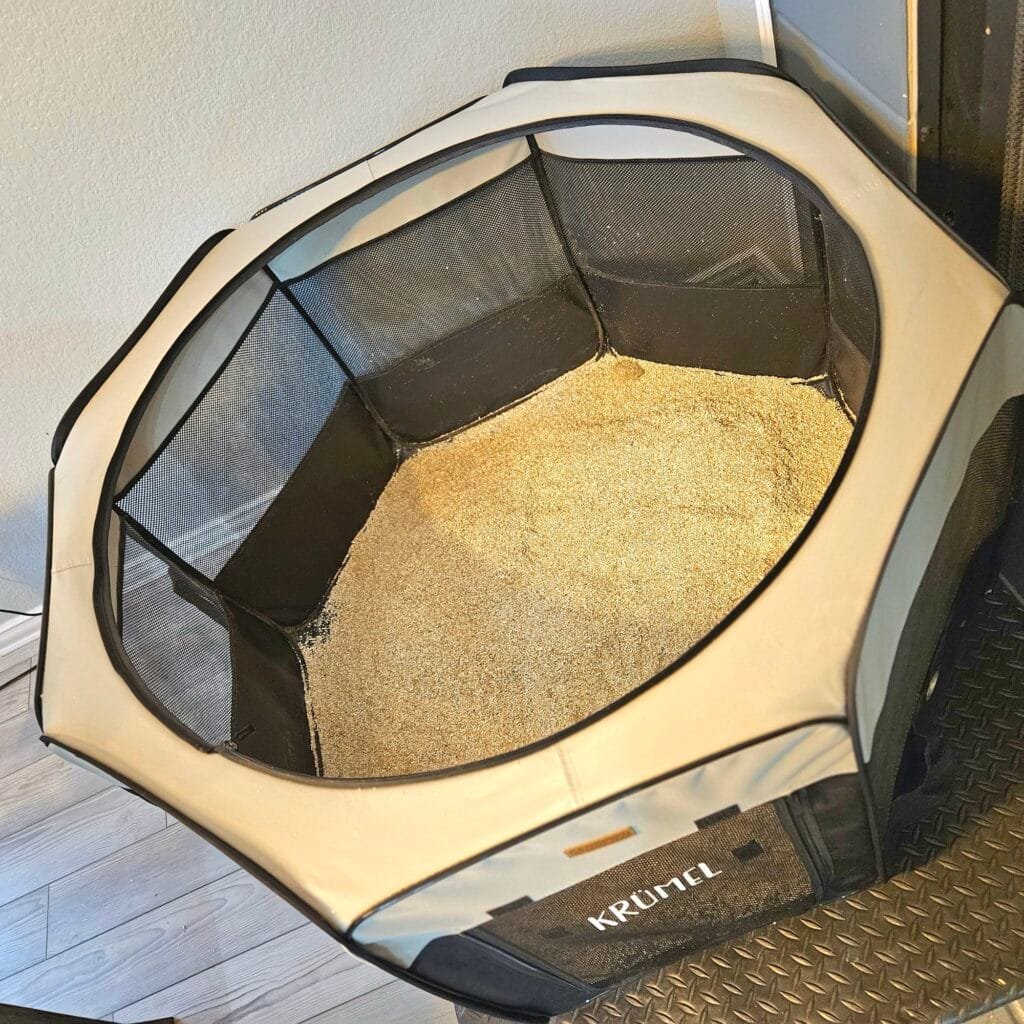
2. Address Nutritional Deficiencies
Nutritional deficiencies, particularly of vitamin E, selenium, and thiamine (vitamin B1), are common causes of wry neck and can often be resolved with supplementation.
- Vitamin E: Administer vitamin E using gel capsules. Cut the capsules open and mix the liquid into the duck’s food or water, or administer it orally with care.
- Selenium: Provide selenium in small, safe amounts. A sprinkle of brewer’s yeast on feed is an excellent source. Be cautious, as excessive selenium can be toxic.
- Multivitamin Supplementation: Add a poultry-specific multivitamin (suck as Nutridrench) to the duck’s diet to address other potential deficiencies.
3. Treat Head or Neck Injuries
If wry neck results from trauma, handle the duck carefully to avoid worsening the injury.
- Consult a veterinarian for anti-inflammatory medications to reduce swelling and nerve pressure.
- In some cases, gentle physical therapy, such as light neck massage, can aid recovery, but this should be performed under veterinary guidance.
4. Use a Neck Brace:
In some cases, a neck brace can help stabilize the duck’s neck and prevent further twisting. This device may be particularly helpful for ducks with more severe cases, as it restricts movement and allows the muscles and ligaments to heal. It may also provide relief from discomfort caused by the abnormal neck position.
A neck brace works especially well for ducklings, as their bones and muscles are more pliable and responsive to such treatment. It can help prevent the condition from worsening and aid in faster recovery.
A vet can guide you on how to properly use the brace and determine if it’s suitable for your duck, especially in the case of ducklings. The brace should be fitted carefully to avoid causing further stress or injury, and it should be monitored regularly to ensure it is not too tight or causing additional issues.
5. Physical Therapy
For ducks with severe muscle weakness or nerve damage from wry neck, gentle physical therapy can help strengthen neck muscles and improve mobility. This may include simple exercises like massaging the neck to improve blood flow, stretching to increase flexibility, and encouraging normal head movements to stimulate muscle function.
If the duck struggles to hold its head up, supportive positioning can help encourage movement without causing strain. Before starting physical therapy, consult a veterinarian to ensure the exercises are safe and appropriate for your duck’s condition.
6. Manage Neurological Disorders or Infections
When wry neck is due to neurological conditions or infections, veterinary care is crucial.
- Bacterial Infections: Antibiotics may be prescribed to address infections affecting the nervous system.
- Viral Infections: Supportive care, including hydration and nutritional support, helps the duck recover as its immune system fights the virus.
- Botulism or Toxins: Detoxification treatments, such as activated charcoal or specific antidotes, may be required if botulism or heavy metal poisoning is suspected.

7. Address Inner Ear Infections
Inner ear infections can cause balance issues and neck twisting.
- Antibiotics are often effective in treating these infections.
- A veterinarian may clean the ear canal if needed.
8. Provide Supportive Care for Hydration and Nutrition
Ducks with wry neck often struggle to eat and drink.
- Hand-feed soft foods like scrambled eggs mixed with vitamin supplements.
- Ensure hydration by offering clean water directly or, if necessary, using a syringe for careful administration.
9. Improve Living Conditions
If environmental stressors are contributing factors, take steps to improve the duck’s habitat.
- Provide a clean, predator-proof enclosure with ample space and fresh water.
- Minimize stress by avoiding overcrowding, loud noises, and extreme weather conditions.
10. Long-Term Management and Monitoring
Recovery from wry neck can take weeks or even months, especially in cases caused by long-term deficiencies or congenital issues.
- Continue providing a nutrient-rich diet and supplements until symptoms resolve.
- Reintroduce the duck to the flock gradually, ensuring it is not bullied or excluded.
11. Consider Humane Euthanasia for Severe Cases
In rare cases where the condition does not improve despite treatment and the duck’s quality of life is severely compromised, consult with a veterinarian about the possibility of humane euthanasia.
Patience and Persistence are Key
Early detection and a comprehensive treatment plan greatly enhance the chances of recovery. With proper care, many ducks with wry neck regain their mobility and return to normal activities. Regular monitoring and preventive care can help avoid future occurrences.
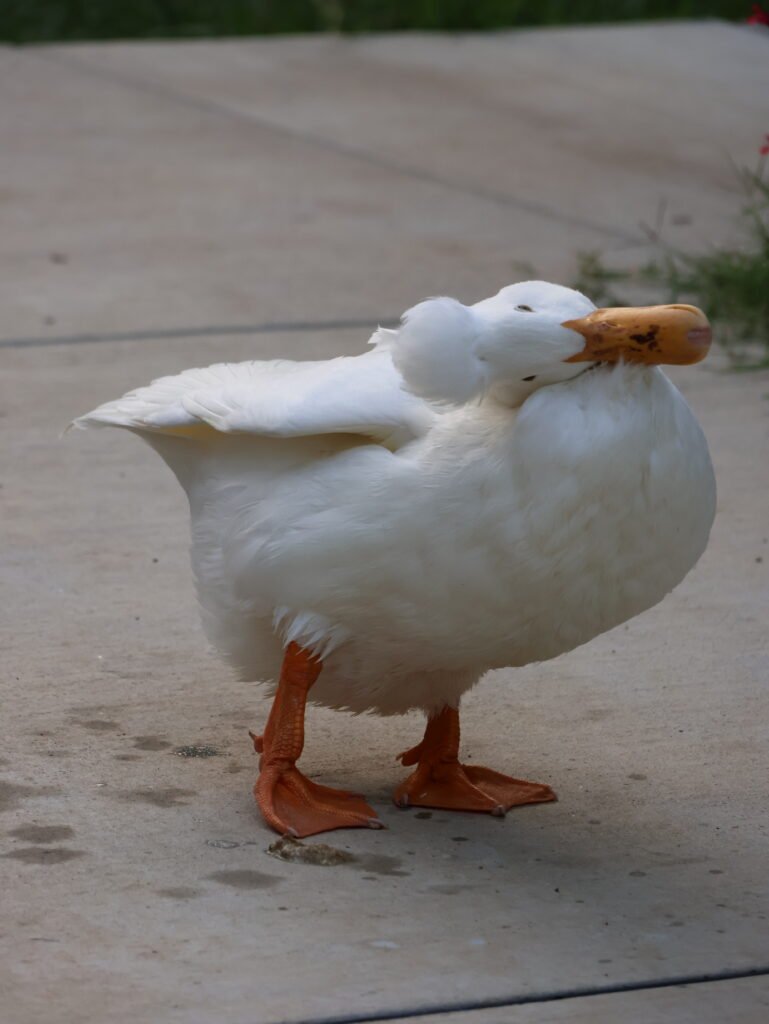
Prognosis for Ducks with Wry Neck
The prognosis for ducks with wry neck depends on the underlying cause, the severity of the condition, and how quickly treatment is initiated. With prompt and appropriate care, many ducks recover fully, regaining normal neck posture and motor function. However, the timeline for recovery and the overall outcome can vary widely.
1. Favorable Prognosis
Ducks with mild cases of wry neck, particularly those caused by nutritional deficiencies, often have an excellent prognosis. When vitamin E, selenium, and thiamine supplementation is started early, significant improvement can be seen within days or weeks. Young ducklings, in particular, respond well to proper nutrition, as their developing bodies can quickly compensate and repair damage.
2. Chronic or Severe Cases
In cases where wry neck is caused by long-term deficiencies, congenital issues, or trauma, recovery may take weeks or even months. While these ducks may improve with consistent care, their recovery might not be complete. Some ducks retain a slight tilt or twist in their necks, but they can often adapt and live normal, happy lives with minor accommodations, such as easier access to food and water.
3. Infectious or Toxic Causes
When wry neck stems from infections or toxins, such as botulism or heavy metal poisoning, the prognosis depends on the extent of the damage and how quickly treatment is administered.
- Botulism: Ducks treated early with detoxification and supportive care have a good chance of recovery. However, delayed treatment can result in severe nerve damage or death.
- Metal Poisoning: Chelation therapy is effective in many cases, but the recovery process is longer, and the prognosis can be guarded if the duck ingested a significant amount of metal.
4. Neurological Disorders
Neurological disorders, such as genetic conditions or diseases affecting the central nervous system, often result in a more guarded prognosis. While supportive care can improve the duck’s quality of life, these conditions are less likely to resolve entirely. Ducks with persistent neurological issues may require long-term care and specialized management to ensure they can thrive.
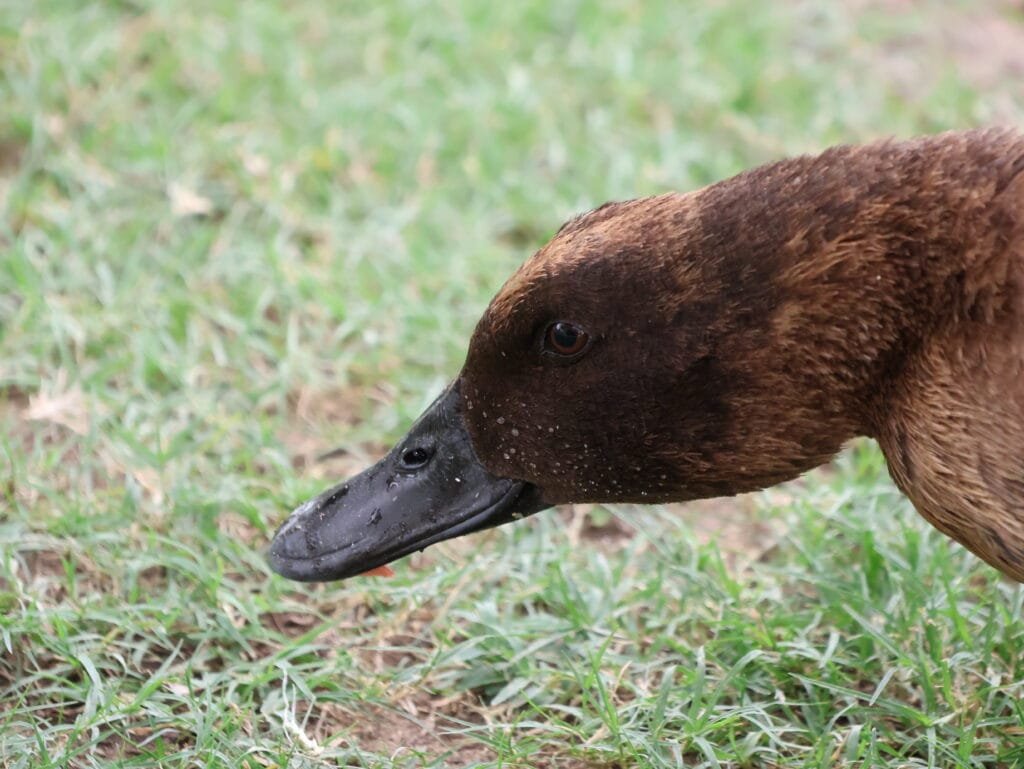
5. Quality of Life Considerations
The quality of life for a duck with wry neck is an essential factor when evaluating prognosis. Ducks that regain mobility can eat and drink on their own and show no signs of pain or distress are likely to have a good quality of life, even if some symptoms persist. For those who fail to improve or show signs of chronic discomfort, humane euthanasia may need to be considered in consultation with a veterinarian.
6. Factors Influencing Prognosis
Several factors affect a duck’s prognosis:
- Age: Younger ducks generally recover faster than older ones.
- Cause: Nutritional deficiencies have a better prognosis than traumatic injuries or genetic disorders.
- Timing of Treatment: The sooner treatment is started, the better the chances of recovery.
- Level of Care: Consistent and supportive care, including proper nutrition, hydration, and stress reduction, plays a vital role in improving outcomes.
7. Long-Term Outlook
Ducks that recover from wry neck typically return to their normal routines, including foraging, swimming, and interacting with the flock. However, it’s essential to maintain a balanced diet, monitor for any recurrence of symptoms, and provide ongoing care as needed. Preventive measures, such as high-quality feed and regular health checks, can help reduce the risk of future issues.
With dedication, patience, and appropriate care, many ducks with wry neck go on to lead healthy and happy lives.
Preventing Wry Neck in Ducks
When it comes to wry neck in ducks, prevention is always better than treatment. Taking proactive measures to ensure optimal nutrition, a safe environment and attentive care can significantly reduce the risk of this condition. Below are expanded strategies to help prevent wry neck in ducks.
1. Provide a Balanced Diet
Nutrition is the cornerstone of preventing wry neck, as deficiencies in key nutrients like vitamin E, selenium, and thiamine are common causes.
- High-Quality Feed: Choose a high-quality duck or waterfowl-specific feed that meets their nutritional needs. Avoid relying on chicken feed, as it may lack the necessary nutrients for ducks.
- Supplementation:
- Add brewer’s yeast to their diet to boost selenium levels, especially for young ducklings.
- Include treats rich in vitamin E, such as sunflower seeds, spinach, broccoli, and peas.
- Provide grains, legumes, and vegetables to supply thiamine.
- Fresh Food and Water: Ensure that ducks always have access to clean water and fresh food, as spoiled or moldy feed can lead to toxin exposure.

2. Ensure Access to Forage
Ducks benefit from natural foraging, which allows them to obtain additional nutrients from insects, plants, and algae.
- Maintain a healthy outdoor environment with access to grass, ponds, or streams to encourage foraging behavior.
- Rotate their foraging area to prevent overuse and contamination.
3. Minimize Stress
Stress can weaken a duck’s immune system, making them more susceptible to infections or other health issues that may contribute to wry neck.
- Provide a Safe Habitat: Ensure their enclosure is predator-proof and free of hazards.
- Avoid Overcrowding: Overcrowded conditions can lead to aggression, injuries, and stress.
- Handle Gently: Reduce handling to necessary situations, and do so calmly and gently.
4. Prevent Injuries
Trauma to the head or neck is a common cause of wry neck.
- Remove hazards like sharp edges, low-hanging wires, or unstable objects from their living area.
- Supervise interactions with other animals, especially larger or more aggressive species.
- Use ramps and non-slip surfaces to prevent falls.
5. Monitor for Early Signs of Illness
Regular health checks can catch early signs of nutritional deficiencies, infections, or injuries before they progress to wry neck.
- Behavioral Changes: Watch for lethargy, difficulty eating, or unusual posture.
- Physical Symptoms: Look for swelling, wounds, or abnormal neck positioning.
- Routine Vet Visits: Schedule regular checkups with a veterinarian experienced in waterfowl care.
6. Avoid Exposure to Toxins
Toxins, such as mold, botulism, or heavy metals, can contribute to wry neck.
- Keep Feed Dry and Clean: Store feed in airtight containers to prevent mold growth.
- Remove Stagnant Water: Regularly clean water sources to avoid the growth of bacteria or algae that produce toxins.
- Inspect the Environment: Remove potential sources of metal or other harmful substances from their habitat, such as rusted nails, wires, or old paint.

7. Provide Adequate Selenium Levels
Selenium is critical but must be given in proper amounts to avoid toxicity.
- If your region’s soil is selenium-deficient, consider adding a supplement or selenium-rich feed.
- Avoid over-supplementation by consulting with a veterinarian about your ducks’ specific dietary needs.
8. Maintain Flock Health
Healthy flock management prevents the spread of diseases that can contribute to neurological issues.
- Quarantine new ducks for at least two weeks before introducing them to the flock.
- Practice biosecurity to prevent the introduction of pathogens.
9. Breed and Genetic Considerations
Wry neck is sometimes hereditary, particularly in certain breeds or due to inbreeding.
- Source ducks from reputable breeders who prioritize healthy genetics.
- Avoid breeding ducks with a history of wry neck or other neurological conditions.
10. Provide Environmental Enrichment
A stimulating environment helps ducks remain active and healthy.
- Offer areas for swimming, foraging, and exploring.
- Rotate toys or introduce safe, new elements like floating lettuce in the pool to keep them engaged.

Consistency is Key
The most effective way to prevent wry neck is to combine good nutrition, safe living conditions, and attentive care. By maintaining a healthy and enriching environment, you can help your ducks thrive and reduce the risk of this condition. Regular vigilance and a proactive approach to their care can make all the difference in keeping your flock happy and healthy!
Wry Neck in Ducks: Key Takeaways
Wry neck, a condition where a duck’s neck twists abnormally, can stem from nutritional deficiencies, injuries, infections, or genetic factors. Understanding the causes, symptoms, treatment, and prevention is crucial to ensuring the health of your flock.
Key Points:
- Symptoms: Signs include difficulty holding the neck straight, trouble eating or drinking, lethargy, and in severe cases, inability to stand or walk. Early detection is vital for effective treatment.
- Causes: Nutritional deficiencies in vitamin E, selenium, or thiamine are common culprits, along with head trauma, infections like botulism, or genetic predispositions.
- Treatment: Treatment focuses on correcting nutritional deficiencies with supplements, supportive care such as hand-feeding and hydration, and addressing any underlying infections or injuries. Consult a vet for persistent or severe cases.
- Prognosis: With prompt care, many ducks recover fully, but long-term management may be required for severe cases. The prognosis depends on the underlying cause and the timing of intervention.
- Prevention: Preventative measures include providing a balanced diet with adequate vitamins and minerals, minimizing stress and injury risks, ensuring a safe environment, and practicing good flock management and biosecurity.
By maintaining vigilant care, offering a nutrient-rich diet, and creating a safe environment, you can significantly reduce the risk of wry neck in your ducks. Recognizing the signs early and taking immediate action ensures the best outcomes for your feathered friends.
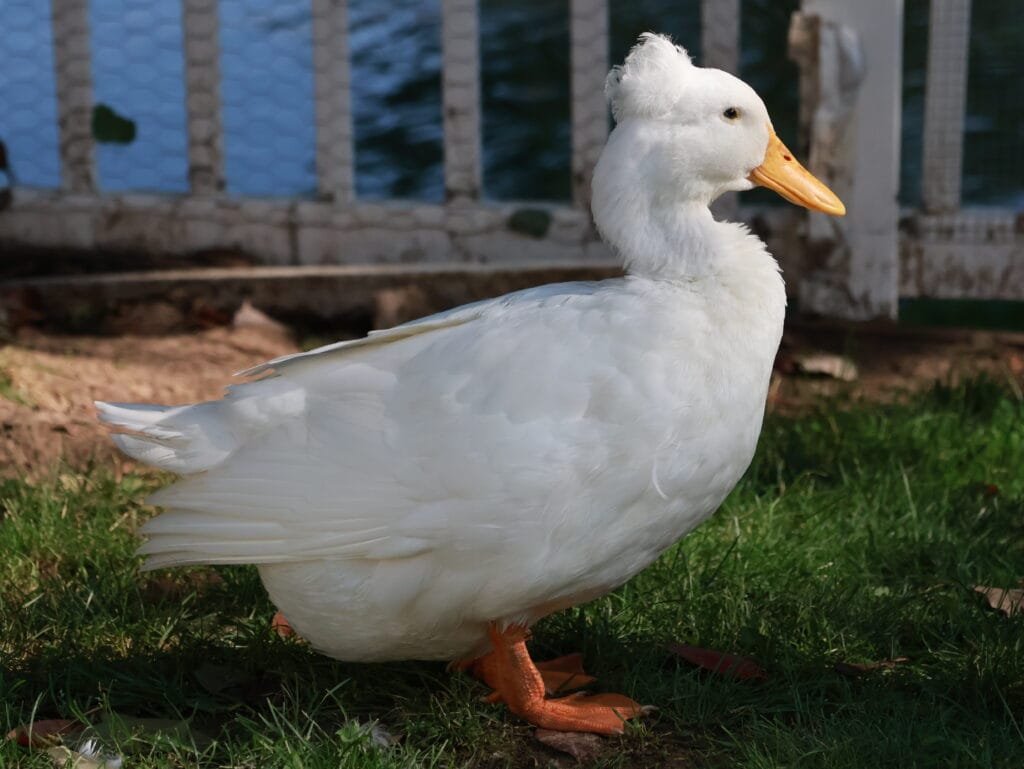
Wry Neck in Ducks: Q&A
Q1: What are the most common causes of wry neck in ducks?
A1: Wry neck in ducks is often caused by nutritional deficiencies, especially in vitamin E, selenium, and thiamine. Other potential causes include head injuries, infections like botulism, or genetic factors. Poor-quality feed, inadequate foraging, or exposure to toxins can also contribute to the condition.
Q2: How can I tell if my duck has wry neck?
A2: Common signs of wry neck include an abnormal twisting or tilting of the neck, difficulty eating or drinking, uncoordinated movements, lethargy, and sometimes a lack of balance when standing or walking. If these symptoms appear suddenly or worsen, it’s important to consult a veterinarian.
Q3: Can wry neck in ducks be treated?
A3: Yes, wry neck can often be treated, particularly when caught early. Treatment typically involves addressing any nutritional deficiencies, such as supplementing with vitamin E, selenium, or thiamine. Supportive care, such as hand-feeding and ensuring proper hydration, may also be needed. In some cases, antibiotics or other treatments may be required if an infection is the cause.
Q4: How long does it take for a duck to recover from wry neck?
A4: The recovery time depends on the severity of the condition and how early treatment begins. Mild cases may improve in a few days to weeks, while more severe or chronic cases may require months of supportive care. Regular monitoring and follow-up with a vet will help ensure proper healing.
Q5: How can I prevent wry neck in my ducks?
A5: Prevention involves providing a balanced diet with adequate levels of vitamin E, selenium, and thiamine, ensuring access to high-quality, properly stored feed, and preventing injuries in the duck’s environment. Regular health checks, safe foraging areas, and minimizing stress also play a key role in preventing wry neck.
Q6: Can wry neck be hereditary?
A6: Yes, wry neck can be hereditary, particularly in some breeds that are prone to neurological issues. If wry neck is observed in multiple generations, it may be a genetic factor. Sourcing ducks from reputable breeders who prioritize healthy genetics can reduce this risk.
Q7: Should I isolate a duck with wry neck from the flock?
A7: If the duck is struggling to eat or drink or shows signs of aggression or weakness, it’s a good idea to isolate them to ensure they receive the proper care and prevent injury from other ducks. Once they start recovering, they can be slowly reintroduced to the flock.
Q8: Is there a way to test for wry neck in ducks?
A8: There is no specific test for wry neck. Diagnosis is typically based on the visible symptoms and a process of elimination to rule out other causes such as infections, toxins, or injuries. A veterinarian may run blood tests or imaging to determine the underlying cause.
Q9: Can wry neck be a sign of a more serious health issue?
A9: In some cases, wry neck can be a symptom of a more serious health issue, such as an infection, toxin exposure, or neurological disorder. It’s important to consult a veterinarian to determine the root cause and develop an appropriate treatment plan.
Q10: Can ducks with wry neck still live a normal life?
A10: With proper treatment, many ducks recover fully and can live normal, healthy lives. However, if left untreated or if the condition is severe, it could lead to long-term mobility issues or other health complications. Timely intervention is key to a positive outcome.




